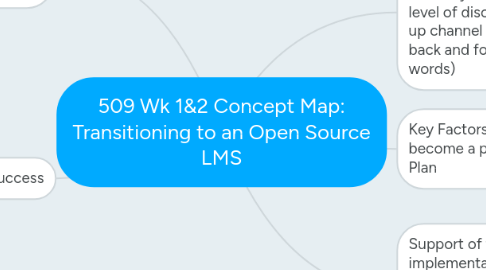509 Wk 1&2 Concept Map: Transitioning to an Open Source LMS
by Cindy Normore


1. Key Barriers to Success
1.1. Lack of Training for Stakeholders
1.1.1. Identification of new roles and responsibilities for staff/users/admin (Normore)
1.1.2. New IT skills and knowledge will be required to support the delivery of education/training via the new open source LMS. This training may be out-sourced in the short-term, and then a train the trainer model applied to support long-term goals for staff development (Normore)
1.2. Stakeholder support. Each stakeholder group needs a clear understanding of the impact of the transition on their area so that they can provide genuine feedback in order to map out best processes. (Campbell)
1.3. Communication, Communication, Communication (Kenny)
1.4. Lack of understanding as to differences between corporate LMS and open-source LMS. Most users fail to recognize the hidden costs associated with Open-source LMSs. Given that there is typically less external support, there is more of a requirement to have skilled everyday users. (Normore)
2. What is likely to Change in the Period involved in Implementing the Plan?
2.1. Budgets: External funding can shift necessitating changes to overall organizational budgets which can impact large projects. There can also be cost overruns requiring another visit to the well. (kenny)
3. Support of the stakeholders may change for the better or for the worse during the implementation. Their support will alter depending on how well some of the barriers to success are dealt with. For example, if there is a lack of communication and training, and no new definition of roles and responsibilities, it is likely that some stakeholders may be less motivated and may become a barrier to change. (Normore)
3.1. I would also add that their will be stakeholder turnover, administrators come and go. New stakeholders will have to be brought up to speed and their views accommodated (S. Kenny)
4. Channels of Communication. To follow on the ideas of Cindy C, communication channels will be key during transition and implementation. To take it a step further, I would also argue that the channels will likely change from the outset through to steady-state. At the beginning, there may be very high level of discussions, a top down channel approach, which will hopefully be modified to be a bottom up channel to capture ideas, buy-in and gather needs from the end users. This channel needs to go back and forth, up and down, persist when necessary, and also subside when necessary. (Normore, 96 words)
5. Key Factors that are likely to become a part of an Implementation Plan
5.1. Relationships between individuals
5.1.1. How will staff/stakeholders view consequences as a result of the implementation of this new open source LMS? (Campbell)
5.1.2. Communication Channels

